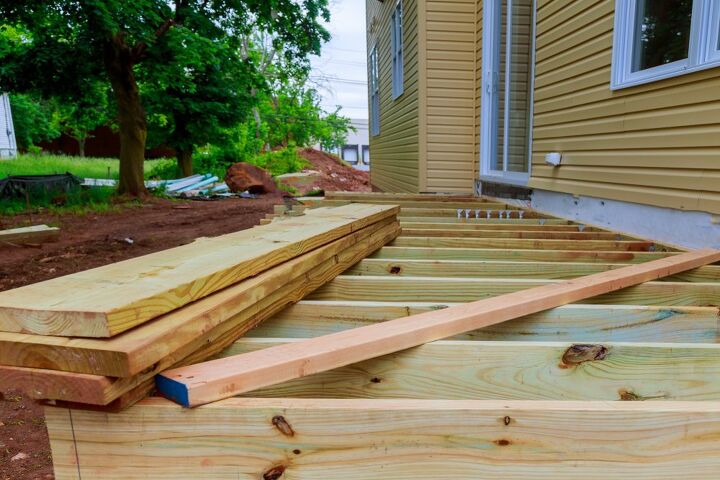What Are The Pros And Cons Of Tigerwood Decking?

Building a deck means that you’re going to have to make a lot of decisions. This includes choosing the right materials for your deck, down to the very wood it’s made from. In recent years, upscale homes have started to build decks from tigerwood. Its popularity definitely got it to earn some stripes, but is it really worth the roar of attention that it’s been getting as of late?
Tigerwood is an excellent choice in terms of durability. It’s naturally mold-resistant, rot-resistant, and even pest-resistant. It also offers a beautiful striped veneer, even when it’s not stained. Unfortunately, tigerwood can be extremely hard to get and fairly expensive.
If you want to make sure that you get the most of your wood shopping, it’s good to learn about each major wood option. Tigerwood is a great choice, but is it right for you?
Do You Need Deck, Porch, or Gazebo Installers?
Get free, zero-commitment quotes from pro contractors near you.

Before We Begin: What Is Tigerwood?
Tigerwood is an exotic hardwood species that has gained a lot of fans over recent years. You might have also heard of this wood called several different names. The most common nicknames it’s given include Congo wood, African walnut, Brazilian koa, bototo, and zorrowood. It’s mostly known for being beautifully striped and having a bold orange-red color. In other words, it looks like a tiger.
The Benefits And Drawbacks Of Tigerwood
While tigerwood is becoming a more common sight, it’s still not super common. This is partly because people don’t know much about this exotic decking option. Let’s look at the perks and pitfalls…
The Pros Of Tigerwood Decking
Having a deck made from tigerwood is definitely something people like seeing. These perks below give you all the more reason to want to choose this material…
- It’s one of the longest-lasting woods on the market in terms of mold and rot resistance. There’s no way to mince words about this. Tigerwood is an amazingly resilient decking wood. It’s resistant to mold, rot, and even certain types of pests…even without a special stain!
- Tigerwood naturally looks amazing. As I said, you don’t need to stain tigerwood to turn it into a gorgeous statement piece. The stripes and bold colors work just as well with a regular seal.
- You can expect tigerwood to last up to 30 years. It won’t scratch, even if you have fairly heavy foot traffic, pet claws scraping against your deck, or even things along the lines of high UV indexes. I really can’t emphasize how much of a hardwood this really is.
- Among designers, it’s a status symbol. It’s true. Tigerwood is one of those deck materials that people who have a keen eye for luxury love. It’s hard not to sound like you’re bragging when you tell someone that they’re standing on genuine tigerwood, you know.
The Problems With Tigerwood Decking
Tigerwood might be popular, but it’s not something that you will see everywhere you go. It’s often a decking material that is only found in certain parts of the country. There are reasons for this, of course. Here’s why it’s not selling like hot cakes…
- Tigerwood is one of the most notoriously expensive decking wood options on the market. If you thought that cedar is expensive, wait until you see tigerwood. Currently, tigerwood takes the top of the rank as one of the most expensive woods on the market. Considering that we’re also in a wood shortage, it’s safe to say that most people will find this to be out of their budget reach.
- The darkness of the wood can absorb heat. This is technically not a “con” in the full sense of the word, but it can be bad. If you live in an area that’s known for bright sunlight and high heat, you might find that the wood’s too hot for your feet…or your pets’ feet. We suggest getting mats for the decking if it gets too hot.
- It will take longer to install a tigerwood deck than other types of decking. Tigerwood’s incredibly heavy density means that you will get more years out of it. Unfortunately, that also means that drilling and hammering will take more effort and time. You will have to be patient with your installation crews. It’ll be pricier and more time-consuming.
- Sourcing tigerwood can be difficult, and there may be some ethical issues too. If you live out in the middle of nowhere, you probably are going to have to special-order tigerwood decking from a major retailer. This can lead to shipping fees that are rather shocking. Moreover, tigerwood is not always harvested ethically. So, you might be on the wrong side of history there.
- There are some composite woods that can mimic the look for far cheaper. Obviously, this isn’t a negative, but it is something that you may want to consider. If you’re just into tigerwood for looks, then you might just want to save some money by going for a synthetic version. Just saying.
How Much Does Tigerwood Cost?
Obviously, you’re going to have to keep the price of tigerwood in mind if you want to make your home look amazing with it. The problem is, this is a material that’s currently in flux. Tigerwood decking costs between $8 to $15 per square foot during normal times, not including installation fees that can range from $9 to $10 per square foot on top of that.
It’s important to remember that, hey! We’re in a lumber shortage! The pandemic has made it hard to keep lumber prices affordable, even when the lumber is pretty local to the purchase. As a result, you may have to spend as much as double the price of what it normally would be.
Is Tigerwood Decking Worth It?
Tigerwood decking is the type of building material that most people would approve of. In fact, it’s one of those types of wood decking that will make people nod in approval, even when they aren’t exactly deep into the world of home improvement. As a status symbol in decking, you really can’t go wrong with it.
The bottom line is that it may be expensive, this wood is definitely worth the money that you will pay for it. Between the excellent durability, the beautiful colors, and the ability it has to resist most types of rot, we have to say that tigerwood will never be a bad decking choice. If you can afford it, by all means, get it. You’ll be happy that you did.
Do You Need Deck, Porch, or Gazebo Installers?
Get free, zero-commitment quotes from pro contractors near you.

Related Questions
Is tigerwood the same thing as ipe wood?
While both tigerwood and ipe wood are seen as excellent picks for decking materials, the truth is that they are not the same wood. They are very separate species that have a similar appearance and similar uses. Ipe, though, tends to be slightly harder and more durable than tigerwood. With that said, you really can’t go wrong with either option.
Do you need to seal tigerwood decking?
Even though you technically don’t need to have a sealant, the truth is that tigerwood will always perform best with a sealant. The best option for a tigerwood deck sealant will be one that is able to sink into the pores of the wood and slowly penetrate through the wood. This will help ensure that you won’t need to re-seal your wood anytime soon.
Is tigerwood hard to work with?
While tigerwood is known for having hardwood, it’s not a hardwood to work with. (See what I did there?) Most woodworking experts agree that this particular type of lumber is moderately difficult to work with. It’s not going to be good for fine cuts and intricate details. However, it doesn’t have many knots and holes. This makes it a great decking material as well as a decent siding material. With moderate skill, a woodworker should be able to work with tigerwood without too many hiccups.
Related Guides

Ossiana Tepfenhart is an expert writer, focusing on interior design and general home tips. Writing is her life, and it's what she does best. Her interests include art and real estate investments.
More by Ossiana Tepfenhart



























